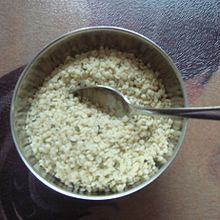Uses
Hemp is used for a wide variety of purposes, an estimated 50,000 products can be produced from hemp in the United States, including the manufacture of
cordage of varying
tensile strength, everlasting clothing and nutritional products. The
bast fibers can be used in 100% hemp products, but are commonly blended with other organic fibers such as
flax,
cotton or
silk, for apparel and furnishings, most commonly at a 55%/45% hemp/cotton blend. The inner two fibers of hemp are more woody, and are more often used in non-woven items and other industrial applications, such as
mulch, animal bedding and litter. The
oil from the fruits ("seeds") oxidizes (commonly, though inaccurately, called "drying") to become solid on exposure to air, similar to
linseed oil, and is sometimes used in the manufacture of oil-based paints, in creams as a moisturizing agent, for cooking, and in plastics. Hemp seeds have been used in bird seed mix as well.
[17] Hempseed is also used as a
fishing bait.
[18]
Hemp seeds contain all the
essential amino acids and essential fatty acids necessary to maintain healthy human life.
[19] The seeds can be eaten raw, ground into a meal, sprouted, made into
hemp milk (akin to
soy milk), prepared as tea, and used in baking. The fresh leaves can also be eaten in salads. Products include cereals, frozen
waffles, hemp tofu, and nut butters, to name a few. A few companies produce value added hemp seed items that include the seed oils, whole hemp grain (which is sterilized by law in the United States, where they import it from China and Canada), dehulled hemp seed (the whole seed without the mineral rich outer shell), hemp flour, hemp cake (a by-product of pressing the seed for oil) and hemp protein powder. Hemp is also used in some organic cereals, for non-dairy milk
[20] somewhat similar to soy and nut milks, and for non-dairy hemp "ice cream."
Within the UK, the
Department for Environment, Food and Rural Affairs (Defra) has treated hemp as purely a non-food crop. Seed appears on the UK market as a legal food product, and cultivation licenses are available for this purpose. In North America, hemp seed food products are sold, typically in health food stores or through mail order. The
United States Department of Agriculture estimates that "the market potential for hemp seed as a food ingredient is unknown. However, it probably will remain a small market, like those for sesame and poppy seeds."
[21]
A survey in 2003 showed that more than 95% of hemps seed sold in the
EU was used for animal feed (bird seed, bait for fishing)
[9]
[edit] Nutrition
| This article appears to contradict the article Essential amino acid. Please see discussion on the linked talk page. Please do not remove this message until the contradictions are resolved. (August 2010) |
Approximately 44% of the weight of hempseed is healthy edible oils, containing about 80%
essential fatty acids (EFAs); i.e.,
linoleic acid,
omega-6 (LA, 55%),
alpha-linolenic acid,
omega-3 (ALA, 22%), in addition to
gamma-linolenic acid,
omega-6 (GLA, 1–4%) and
stearidonic acid,
omega-3 (SDA, 0–2%). Protein is the other major component (33%), second only to soy (35%), but more easily digestible because it's primarily
globular proteins, 33%
albumin and 65%
edestin (a Greek word meaning edible). Its
amino acid profile is close to "complete" when compared to more common sources of proteins such as meat, milk, eggs and
soy.
[23] The proportions of linoleic acid and alpha-linolenic acid in one tablespoon (15 ml) per day of
hemp oil easily provides human daily requirements for EFAs. Unlike
flaxseed oil, hemp oil can be used continuously without developing a deficiency or other imbalance of EFAs.
[24] This has been demonstrated in a clinical study, where the daily ingestion of flaxseed oil decreased the endogenous production of GLA.
[24]
Hempseed is an adequate source of
dietary fiber,
calcium and
iron, and contains
antioxidants and
chlorophyll. Whole hempseeds are also a good source of
phosphorus,
magnesium,
zinc,
copper and
manganese.
Hempseed is usually very safe for those unable to tolerate nuts,
gluten,
lactose, and
sugar. In fact, there are no known allergies to hemp foods.
[citation needed] Hempseed contains no gluten and therefore would not trigger symptoms of
celiac disease.
[citation needed]
[edit] Storage
Hemp oil can spontaneously oxidize and turn rancid within a short period of time if not stored properly; it is best stored in a dark glass bottle, in a refrigerator or freezer (its freezing point is –20 °C).
Preservatives (
antioxidants) are not necessary for high quality oils that are stored properly.
[edit] Dietary supplement
Hemp oil has been shown to relieve the symptoms of
eczema (
atopic dermatitis).
[25]
Hemp Seed contains a large dietary supplement of
omega-3, higher even than
walnuts which contain 6.3% of n-3.
[edit] Medicine
Hemp oil has anti-inflammatory properties.
[26]
**This article is taken from wikipedia.com

